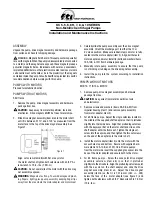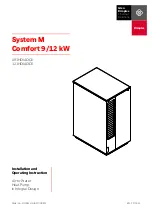
9. Personal Safety:
a. Wear safety glasses at all times when working with
pumps.
b. Keep work area clean, uncluttered and properly
lighted – replace all unused tools and equipment.
c. Keep visitors at a safe distance from work area.
d. Make workshop child-proof – with padlocks, master
switches, and by removing starter keys.
10. When wiring an electrically driven pump, follow all
electrical and safety codes, as well as most recent
National Electrical Code (NEC) and Occupational
Safety and Health Act (OSHA).
11. This equipment is only for use on 115 volt (single
phase) and is equipped with an approved 3-conductor
cord and 3-prong, grounding-type plug.
Risk of electric shock. Connect
only to properly grounded, grounding-type
receptacle. Never connect green (or green and
yellow) wire in cord to a live terminal!
Where a 2-prong wall receptacle is encountered, it must
be replaced with properly grounded 3-prong receptacle
installed in accordance with the National Electrical
Code and local codes and ordinances.
12. All wiring should be performed by a qualified electri-
cian.
13. Make certain that power source conforms to require-
ments of your equipment.
14. Protect electrical cord from sharp objects, hot surfaces,
oil, and chemicals. Avoid kinking cord. Replace or
repair damaged or worn cords immediately.
15. Do not touch an operating motor. Modern motors are
designed to operate at high temperatures.
16. Do not handle pump or pump motor with wet hands or
when standing on wet or damp surface, or in water.
Risk of electrical shock. If your base-
ment has water or moisture on floor, do not walk
on wet area until all power has been turned off. If
shut-off box is in basement, call electric company
to shut-off service to house, or call local fire
department for instructions. Remove pump and
repair or replace. Failure to follow this warning can
result in fatal electrical shock.
Installation
1. This unit can be installed in sump pit with minimum
diameter of 12"(30cm) and depth of 12"(30cm). Sump
pit may be constructed of tile, concrete, steel or plastic.
Check local codes for approved materials.
2. Install pump on solid, level foundation, as near as possi-
ble to center of sump pit. Do not hang pump from dis-
charge pipe or power cord.
Pump must be level (column must
be vertical) when operating.
If motor is tilted,
internal start/run switch may overheat and damage
motor.
3. Pump should not be installed on clay, earth or sand sur-
faces. Clean sump pit of stones and gravel which could
clog the pump. Keep pump inlet screen clear.
4. Thread outlet pipe into pump body carefully to avoid
stripping or crossing threads.
NOTICE:
Do not use ordinary pipe joint compound on
plastic pipe or pump. Pipe joint compound can attack
plastics and damage pump.
5. To reduce motor noise and vibrations, a short length of
rubber hose (1-5/8"(41mm) I.D., e.g. radiator hose) can
be connected into discharge line near pump using suit-
able clamps.
Risk of electric shock. Pump is
designed for 115V., 60 HZ operation and
requires a circuit of 15 amperes capacity. It is
supplied with a 3-wire cord set with grounding-
type plug for use in a 3-wire, grounded outlet.
Do not cut off round grounding prong. For safe-
ty, outlet must be electrically grounded to a
suitable electrical ground such as a grounded
water pipe or a grounded metallic raceway or
ground wire system.
6. Locate Float Rod Guide (Key No. 6) about 6" (16cm)
below motor. Clamp guide to column.
Risk of flooding.
Be sure guide is
securely clamped so float rod is vertical and moves up
and down freely. If float is angled or binds, pump may
not start, allowing flooding to occur.
7. Screw float onto threaded end of rod. Threads on rod
will cut threads into corrosion resistant float.
8. Insert plain end of float rod up through eye of rod guide.
9. Slide one rod stop on float rod before passing rod
through eye of pump switch.
Slide 2nd rod stop on rod after passing through eye of
switch.
Position 2nd rod stop flush with top of rod.
10. Position lower rod stop to within 8"(20cm) of switch
lever arm. With lower rod stop in this position, pump
will automatically cycle at approx. 2-1/2" (6cm) off and
10-12"(25-30cm) on. For faster cycling, move lower rod
stop closer to switch lever arm.
11. If pump discharge line is exposed to outside subfreezing
temperature, portion of line exposed must be installed so
any water remaining in pipe will drain out by gravity.
Failure to do so can cause water trapped in discharge to
freeze resulting in pump damage.
12. Install an in-line check valve to prevent flow backwards
through pump after pump shuts off. Drill a 1/8” hole in
discharge directly above connection to pump to prevent
airlock.
13. After all piping and controls have been installed, unit is
ready for operation.
Risk of flooding.
If a flexible discharge
hose is used, pump may move when motor starts. If it moves
far enough so switch hits side of sump, switch may stick and
prevent pump from starting. Make sure pump is secured so
it cannot move around in sump.
2
Summary of Contents for ST33APP
Page 5: ...5...























